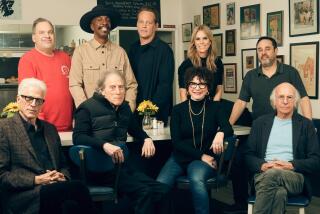Physician, mayor -- and, long ago, heroin addict
Donald Kurth stood in a New Jersey courtroom in 1969 at the mercy of the judge.
A heroin addict, Kurth had been arrested for petty larceny and drug possession. His oversized jeans sagged at the waist. His belt had been stolen that week by a corner drug-seller in Harlem.
Perhaps seeing a speck of promise in the 20-year-old, the judge offered him drug rehab instead of jail.
Kurth balked. If he did the time, he’d be back on the street sooner.
Consider it a gift and take it, his attorney told him.
Nearly 40 years later, Dr. Donald Kurth still reaches back to that memory for inspiration. The judge’s gift ultimately led to college and then Southern California, where he is chief of addiction medicine at Loma Linda University Behavioral Medical Center -- and mayor of Rancho Cucamonga.
“It’s like the story of the comeback kid,” said Kurth, now 57. “I knew my life was spiraling out of control, but luckily, I was able to pull it out.”
*
Kurth grew up in the New Jersey suburbs and was a fan of Timothy Leary, the former Harvard lecturer who promoted the benefits of LSD.
He sipped his first alcohol at 12, toked his first marijuana at 15.
“It wasn’t like anyone came to the schoolyard and asked me if I wanted drugs,” Kurth said. “I was the one out looking for them.”
Though Kurth was once a gifted student, his top marks soon plummeted.
After narrowly graduating from high school, he flunked out of two small colleges.
“Everyone said he had the highest IQ of his class,” said Kristine Kiley, Kurth’s younger sister. “But he couldn’t attend his own graduation because he was getting into so much trouble.”
Kurth’s father scolded him but was unsure of how to cope with his rebellious son.
So Kurth drifted, ending up in New York. Sometimes he had no place to sleep. Often he huddled in condemned buildings.
He chose cocaine over marijuana, then heroin over cocaine.
“Drugs were brand new then and represented a mutiny against our parents,” Kurth said. “We all believed we could change the world, and we all thought getting high was going to do it.”
*
There is little in Kurth’s life today that hints of those days on the street.
He has a soft face and a graying mustache and speaks with sincere emotion. Diplomas decorate his office at Loma Linda University Behavioral Medical Center.
Three years ago he married Dee Matreyek, who runs the nonprofit Restorative Justice Center, which helps criminals fit into society upon release. The wedding followed nearly two decades of courtship.
“Of course, I was skeptical at first; that’s why we dated on and off for 18 years,” said Matreyek, laughing.
Kurth, who learned policymaking as chairman of various physician organizations, was appointed to an open City Council seat in Rancho Cucamonga in 2002. For someone who had problems making decisions in his youth, the responsibility of being a councilman had great appeal. It showed how far he had come.
In November, he squeaked past incumbent Bill Alexander to become mayor. Kurth got 49.5% of the vote; Alexander, 45.8%.
Some opponents denounced his past at council meetings and handed out fliers detailing his drug history.
During one City Council session, a woman called Kurth a heroin addict.
The next week she apologized and said she misspoke -- that Kurth was actually a cocaine abuser.
“He certainly doesn’t go out and paint a tag that says ‘Look at me,’ but people who try to use his background against him don’t succeed,” said Councilwoman Diane Williams.
*
The attacks were nothing compared with those he survived as a young addict living on the streets.
Once, two men approached Kurth in a rough Harlem neighborhood shortly after he’d bought some drugs.
They frisked him for the heroin, not knowing he clutched it in his hand.
One grabbed Kurth from behind while the other jabbed a knife into his belly.
Blood splotched through his black-and-blue sweater.
He stumbled two blocks to a drug dealer’s apartment, where the two stitched his wounds. A hospital visit was out of the question because a warrant was out for his arrest.
The arrest eventually came, and in 1969 Kurth went before the judge on a brisk winter day.
Challenged by himself and loved ones, he chose drug rehabilitation over jail and enlisted at Daytop, a New York therapeutic center.
Those who relapsed there wore shirts reading “I’m Sorry I Acted Like a Baby.”
The shirt was among Kurth’s most frequently worn accessories.
“I kept telling him, ‘You’ve got it here in the head, Donald,’ ” recalled Msgr. William O’Brien, Daytop’s founder. “He was erratic and he was a scatterbrain, but he had the determination to change his lifestyle.”
Kurth gained respect for his doggedness, and after more than two years of recovery, his hunger for drugs had been replaced with a hunger to learn.
“I was pretty high on being clean, and I felt grateful for my life,” Kurth said. “I wanted to do something with it.”
After his release, he worked at odd jobs, looking for a way to jump-start a stalled education.
After one particularly grueling day working in construction, Kurth walked into Fairleigh Dickinson, the largest private university in New Jersey, and asked to speak with an admissions counselor.
“She did everything but laugh in my face, and asked me why would they want to accept me?” Kurth said. “So I asked to speak with the dean.”
Kurth pleaded with the dean and caught another break. He could take a night course and, if he performed well, would be granted full admission.
He took English 101, and aced the class. It was the first of many successes he had at Fairleigh Dickinson.
A mentor noticed Kurth’s enthusiasm and suggested he apply to top-tier schools. Ivy League schools.
The types of universities skeptical over applicants with a couple of Bs, let alone those with arrest records.
With other schools denying him based on his past, Columbia University took a chance, and he enrolled at the Manhattan college.
“It was pretty awesome and remarkable,” said Kiley, his sister. “I just kept thinking, if these people knew what he had been through, they would be really amazed.”
After graduating with honors, Kurth enrolled at Columbia’s medical school -- one of the best in the nation. He completed an internship at Johns Hopkins University, then ventured west to begin a residency program at UCLA.
But at the same time, he began undergoing treatment for life-threatening colon cancer. Drinking alcohol increases the risk of cancers of the mouth, esophagus, pharynx, larynx and liver in men, and of breast cancer in women, according to the National Cancer Institute.
Kurth’s problems with alcohol had continued beyond the time he quit using drugs, but he hasn’t used it since 1993.
“I suffered through the agony of addiction-related cancer, but I wasn’t going to make mine a tale of woe,” he said.
He was determined not to let the disease be his downfall.
Surgery and a year of chemotherapy sent the illness into remission, and Kurth started working at his current job, the chief of addiction medicine at the Loma Linda Behavioral Medical Center.
His principal responsibility is managing the medicine of patients trying to rid themselves of dependence on drugs -- patients who mirror his past.
“They can relate to me because I can talk to them about my own past,” said Kurth, who champions the benefits of rehabilitation over jail sentences for drug offenders. “It’s very rewarding because you can make a dramatic difference in people’s lives.”
*
Kurth now heads a city that is rapidly turning into a destination for middle-class African Americans, Latinos and Asian Americans.
Since 1995, the city’s population has increased nearly 50%, from 114,000 residents to more than 170,000.
He plans to focus on cutting the city’s crime rate and carefully manage the city’s development and growth, all while maintaining his post at the hospital, aiding those who were once in his shoes.
“I like to stay busy,” Kurth said. “I’ve been fortunate in my life with my recoveries. I’ve been given a new life, so every day is exciting.”
*
More to Read
Sign up for Essential California
The most important California stories and recommendations in your inbox every morning.
You may occasionally receive promotional content from the Los Angeles Times.










